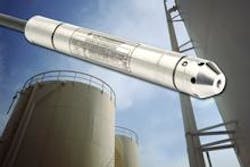New Level, Pressure Transducers Provide Superior Thermal Performance
By Chris Lilly
Specifying pressure and level transducers involves weighing the benefits of high performance vs. cost-efficiency. Where performance is measured by the overall accuracy of the unit, users must pay attention to several areas, including the effects of temperature. For most analog output units, thermal error is stated separately from static accuracy; thus its total effect must be calculated and included in overall accuracy.
Circuit board advancements now allow transducers to incorporate ASIC (Application Specific Integrated Circuit) technology, which enables transducers to maintain high accuracy (≥ ±0.1%) over the entire compensated temperature range. ASIC technology dramatically improves thermal performance over traditional analog outputs and has significantly advanced the performance/cost-ratio of analog transducers.
Traditionally, transducer's accuracies are stated as a percentage of the full-scale output combining errors from non-linearity, hysteresis, and non-repeatability. A separate specification is then cited indicating additional error due to thermal effects. This error is typically stated as a percentage of the full-scale output per degree Celsius of deviation from the median temperature of the calibrated temperature range. With the new ASIC-based transducers, the thermal effects are so minimal that the accuracy can be stated in terms of a total error band (TEB). This total error band combines all potential error sources including non-linearity, hysteresis, non-repeatability, and thermal effects.
Transducers that incorporate ASIC technology offer many benefits over traditional analog output transducers. For example, a new line of level and pressure transducers from Pressure Systems, Inc., the KPSI Series 340 small bore submersible level transducers, incorporates ASIC technology to achieve improved thermal performance. They do so via a combination of feedback from a Wheatstone-bridge in the sensor and sensor specific look-up tables generated during calibration that use a 4th order polynomial correction of the sensor output.
In addition to the low total error band accuracies, the ASIC technology also allows for factory or field re-rangeability of the transducer. Pressure Systems' new Series 740 transducer with ASIC technology, for example, provides for programmable adjustment of the pressure range in the field while offering greatly improved thermal compensation. The ASIC technology facilitates field re-ranging of the transducer output through the attached cable by a factor of up to 10:1, while providing an overall accuracy of up to ±0.25% TEB over the entire compensated temperature range of the transducer.
The ability to re-range a transducer in the field enables periodic adjustment of zero and span, if desired, as well as greater flexibility to inventory transducers locally. In fact, while the re-ranging feature is beneficial to many users of the ASIC transducers, it may be especially useful to stocking distributors. It allows a distributor to carry only two or three nominal ranges, instead of stocking a wider range of transducers. At the time of order placement, the transducer can be custom calibrated to the customer's exact specifications.
For the distributor that also has light fabrication capabilities and the ability to perform field cable attachment to the transducer, ASIC transducers offer the ability to provide a custom calibrated transducer with a custom cable length to their customers. These benefits will allow for faster deliveries, because substantial subassemblies can be prefabricated and then calibrated to the customer's specifications when ordered. They also make the transducers more "market friendly" for original equipment manufacturers (OEM) and stocking distributors by allowing them to order two or three basic ranges and re-range them to suit their needs.
The ASIC transducers with re-ranging capability are especially useful in demanding applications where repeatable, precise measurement is needed, such as in the environmental and industrial water markets. In fact, with their improved thermal performance, all of the ASIC-type level transducers are suited for environmental applications, including monitoring surface water, ground water, or down-hole, because the data from the transducer are virtually impervious to errors from day-night temperature fluctuations. This feature can be especially advantageous in remote, mountainous areas where temperatures can vary 30° to 40° Fahrenheit or more from day to night.
Other environmental applications that may benefit from ASIC-enhanced transducers include rain gauges, evaporation monitoring in remote lakes and reservoirs, and any others that require overall accuracy.
The same features that make the ASIC transducers attractive for environmental applications also make them beneficial for use in tank level measurement applications. The low total error band accuracy allows for accurate level measurement in aboveground storage tanks, underground storage tanks, and elevated storage tanks. The level measurement can be used for various applications with regard to the tanks. It can be used for a simple, accurate local indication of the tank level, as well as with various forms of telemetry for remote level monitoring.
Specifically, the measurement can be used with a pump controller to maintain a level or move liquid into or out of a tank. It can also be used to accurately monitor the level in the tank for purposes of inventory control or inventory tank gauging. The availability of 4-20 mA or vDC analog outputs from a 9 – 30 vDC input allow interface with a variety of controllers, data loggers and displays.
The ASIC transducers are also ideal for use in many other traditional applications where submersible or non-submersible level and pressure transducers are required. These include lift stations, pumping stations, dewatering, or any other application that requires level measurement for pump control.
The ASIC transducers from Pressure Systems Inc. are fully tested and shipped with a traceable calibration card. The Series 340 and Series 740 are CE approved to EN 61000-6-4:2001 and EN 61000-6-2:2001. Both series are integrated with supporting electronics in a waterproof housing constructed of 316SS or titanium. The transducers are available in pressure ranges of 0-5 through 0-100 psig, and 0-15 through 0-100 psis.
About the Author: Chris Lilly is a Sales Engineer with Pressure Systems, Inc. (the manufacturer of KPSI™ Level and Pressure Transducers) in Hampton, VA. He has over 22 years experience in the development, production and sales of electronic instrumentation.

